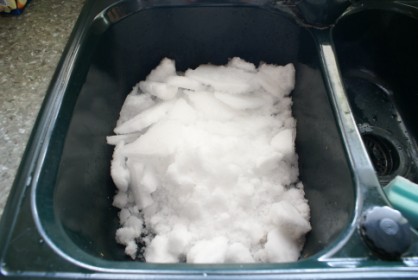Sometimes there’s nothing better than an analogy to help one understand an issue; what is even more effective, though, is using something you are very familiar with to model something that is happening on a much larger, much more destructive scale.
Take the Arctic ice sheet.
Last winter, the thickness of sea ice in large parts of the Arctic fell by nearly half a metre (19 per cent) compared with the average thickness of the previous five winters.
This followed the dramatic 2007 summer low when Arctic ice extent dropped to its lowest level since records began.
Up until last winter, the thickness of Arctic sea ice showed a slow downward trend during the previous five winters, but after the summer 2007 record low extent, the thickness of the ice also nose-dived. What is concerning is that sea ice is not just receding but it is also thinning.
So what if the ice is thinning – surely it’s the area that matters? And you might well think that, until you try defrosting a freezer that is caked with ice: precisely what I did this morning.
Freezers work best when they are full of frozen stuff – the volume of food or liquid being kept frozen helps stabilise the temperature of the entire compartment. This is because solids (and liquids in frozen form) have molecules that are far less mobile than those in the surrounding air. As a gas heats up, even a tiny bit, it becomes more energetic, and is able to spread its heat energy around far more easily than the molecules trapped in the solid. When the freezer is not being cooled, despite the insulation and the cooling effect of the solid food, some cold air has to be circulated to keep the overall temperature down – which is why too much pack ice inside the freezer is a bad thing. That’s the sciencey bit: here’s where it gets interesting.
When you go to defrost the freezer, the first thing to do is remove all the food. Straight away the volume of cold solids is dramatically reduced, allowing the warmer air to circulate. With the freezer switched off, the warmer air gets to work on the ice around the edges pretty quickly. Already there’s an important point being made about why ice on the sea is inherently less stable than land ice – the sea beneath the ice is moving around, exchanging heat all the time, whilst the land just sits there doing its cold thing.
Now, some people advocate putting basins of hot water on the shelves, and using a hairdryer (or even a heat gun!) to get rid of the ice. I prefer the mechanical method, which mimics nature rather well:
1) First I remove any soft, surface ice. This is the kind that melts first in Arctic summers, having little mass, and a very large surface area, but providing some protection to the harder ice below.
2) Next I watch for melting patches as the ambient air does its job – the first ice to spontaneously melt are the very thin sheets that line the door and, shortly after, the underside of the shelves. This is pretty easy to break up with a wooden spatula, handily apeing the action of the sea crashing against the thin edges of the ice sheet.
The important point here is that already the thinness of the ice is very significant. Because of the lower volume, there is less intrinsic “coolness” within the sheet of ice than with the thicker slabs lining the bottom of the shelves, and the very top of the freezer. The same goes for the Arctic ice sheet: the thinner the ice, the quicker it melts, exposing more of the darker sea to the sun, which then absorbs more heat causing further thinning at the edges.
Bad stuff.
3) After a while even the thicker ice starts to break up. The vibration stresses of my spatula in other parts of the freezer cause small cracks to appear in the topmost ice. The cracks can be entered by air and (very importantly) melting water, which lubricates the surface of the ice blocks, and down they come!
Again, this is what happens in the Arctic: as the ice melts, water enters cracks, lubricating the edges of the (now) independent ice floes which can then be eroded by the moving sea. The thinner the ice, the more likely the cracks are to span the entire depth of the ice.
4) Finally, the standing ice on the shelves, not subject to gravity can be lifted off because the meltwater from other parts of the freezer is starting to seep beneath it. Not a sea ice issue, but still significant.
As you can see, just by observing how ice behaves in a warming freezer, you can understand why the thickness of Arctic sea ice is so very important. Don’t let anyone tell you it is ok next year because the area of ice may have expanded a bit (I don’t know if it ever will); look at how much the ice is getting thinner, then you will see how dangerous things are getting in the global freezer.
